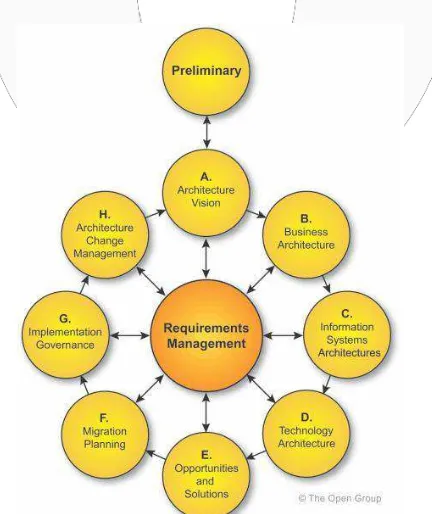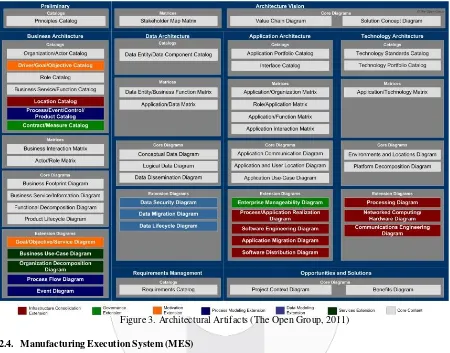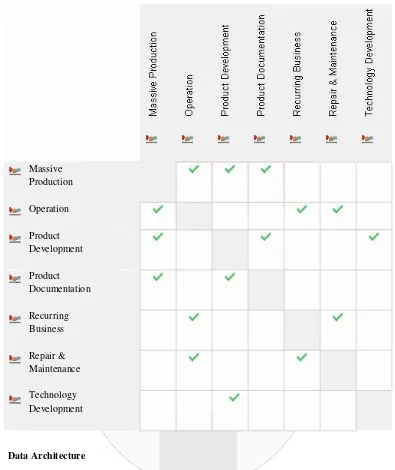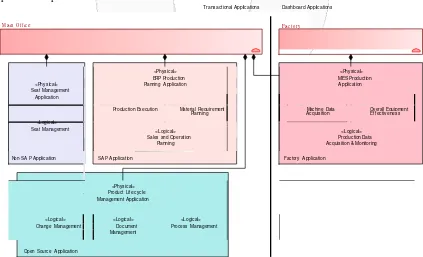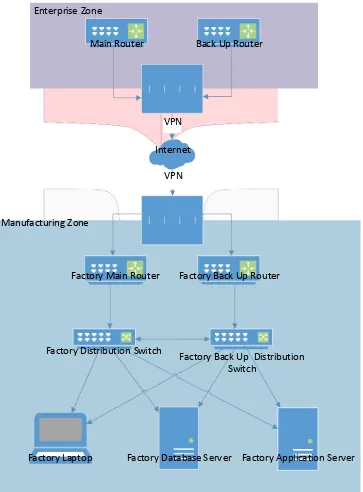ANALYSIS AND DESIGN OF ENTERPRISE ARCHITECTURE USING TOGAF
ADM IN PRODUCT DEVELOPMENT DIVISION AND PRODUCTION AND
OPERATION DIVISION OF PT. INTI (PERSERO)
TELKOM UNIVERSITY
Inas Nisrina1, Yuli Adam Prasetyo2, Rahmat Mulyana3
1,2,3
Information System Department, Industrial and System Engineering Faculty, Telkom University
, 2[email protected], 3[email protected]
Abstract
PT. Industri Telekomunikasi Indonesia (Persero) or PT. INTI (Persero) is a state-owned enterprise in telecommunication industry as a case study of this research, has already a manufacturing business But PT. INTI wants to make the business is bigger for the long-term target plan. Thus, to make it happen, EA can help the enterprise to align the business and IT, and also to see the gap between the baseline and target architectures, in order to make the business improvement. These architectures include the business, data, information, and technology architecture. In this research, The Open Group Architecture
Framework’s Architecture Development Method (TOGAF ADM) is used. This framework includes the
guidance of the overall process in designing architectures, with a cycle-based method and some phases. This research consists of 6 phases of TOGAF ADM (from Preliminary Phase until the Opportunities & Solutions Phase), and the study is about the Product Development and Production & Operation Division in PT. INTI. Manufacturing Execution System can help to improve the manufacturing execution process operations, to improve the manufacturing business of the enterprise.
Keywords: Enterprise Architecture, PT. INTI, TOGAF ADM, Product Development Division, Production & Operation Division
1. Introduction
1.1. Background
Information technology is a part of the information system that has been used in this era. In fact, information technology in the business entity or large company is a requirement that must be met, in order to reach the goals of the company. With the information technology, business processes can be done effectively and efficiently, or may be called as well as the automation of business processes. So do not wonder anymore, large companies compete with each other to seek the advancement of technology and information systems they have. Kalevi Pessi (2011) says that the role of information systems or IS has also changed over the past two decades, from the automation of routine tasks of administration, to be the strategic and competitive weapon.
PT. Industri Telekomunikasi Indonesia (Persero) or PT. INTI (Persero) is a state-owned enterprise that is already engaged in the telecommunications industry for 35 years, and has been entrusted to provide systemic solutions for leading telecom operators in Indonesia. PT. INTI already uses information technology well, such as the implementation of Enterprise Resource Planning (ERP) with Systems, Applications and Products in Data Processing, or SAP which became a transformation or a major leap forward for PT. INTI in 2012. SAP has been used in each of the business functions that exist in the company.
In 2009-2015, the business of PT. INTI focus on engineering solutions, system integrators and development of original products of PT. INTI. Whereas in 2016, PT. INTI will change the company's business focus to be the manufacturing or production, in a long-term plan. Thus, with respect to the change of business focus of the
company, author wants to recommend some innovations in order to reach the company’s new business goals.
1.2. Objective
The objective of this research is Analyze baseline EA and design target EA (business, application, data, and technology architecture) using TOGAF ADM in Product Development and Production & Operation Division in PT. INTI.
1.3. Problem Identification
Based on the background of this research, problems that can be identified is how to analyze baseline EA and design target EA (business, application, data, and technology architecture) using TOGAF ADM in Product Development and Production & Operation Division in PT. INTI.
1.4. Research Conceptual Model
The conceptual model describes the concept design of enterprise architecture in PT. INTI, both baseline as well as the target. Design of the baseline EA will be done first, and the next step is analysis of the target EA that is right for the company, with the same conceptual model. Finally, if the design of baseline and target EA are completed, gap analysis can be performed and the roadmap can be developed. The conceptual model of this research is illustrated in Figure 1. Conceptual Model.
Current IT Master Pl an Future Pl an of PT INT I
Archi tecture Pri ci pl es Archi tecture Vi si on Busi ness Informati on Requi rement
Busi ness Archi tecture of
Data Components Archi tecture of Product Devel Informati on System opm ent and Product & Channel Management
Di vi si ons Data Archi tecture Bl uepri nt
Appl i cati on Components Appl i cati on Archi tecture
2. Basic Theory and Methodology
2.1. Enterprise Architecture
Kalevi Pessi (2011) says that Enterprise Architecture is an expression of the operational alignment between business needs with asset information system has been set up as a response to the business environment. So, EA can reveal strategic alignment or misalignment between business architecture, information systems architecture (applications and data), and technology architecture.
Enterprise Architecture is usually divided into domains or different types of architecture. Aerts et al. (2004) also describes the three domains of architecture at EA:
a. Business architecture defines business systems in an organization or company.
b. Information systems architecture (applications and data) to describe the business information system components and their interactions.
c. Technologically architecture is an architecture that will be used as a platform for the construction and operation of the system.
The purpose of the enterprise architecture is to optimize the entire process of the company (both manual and automatic), so it can be integrated environment that is responsive to change and support the delivery of business strategy (The Open Group, 2011). Toomas Tamm, Peter B. Seddon, Graeme Shanks, and Peter Reynolds (2011) explain that the organization's benefit can be obtained from the EA. The benefits derived come from increasing organizational alignment, availability of information and resources. Such an advantage can be lower costs, higher strategic agility, and more reliable operating platform.
2.2. Methodology (TOGAF ADM)
TOGAF enterprise architecture divides into four categories, namely business, data, application, and technology architecture. TOGAF describes itself as a framework, but the most important parts of TOGAF are the Architecture Development Method (ADM). ADM is a process for making architecture. So, TOGAF ADM can be categorized as an overall process architecture (Roger Sessions, 2007).
ADM illustrate a method for developing and managing the life cycle of enterprise architecture, and forms the core of TOGAF. ADM integrate TOGAF elements, as well as other architectural assets available to meet the needs of the business and the IT organization (The Open Group, 2011).
Lou Varveris & Dave Harrison (2005) explain that as an enabler of EA, TOGAF provides the following benefits: a proven method that has common vocabulary, communication, decision management, can reduce complexity, and business alignment with information technology. Such benefits can be obtained for TOGAF is a thorough and detailed methodology for EA. The cycle of TOGAF ADM is shown in Figure 2. Architecture Development Cycle (The Open Group, 2011).
2.3. Architectural Artifacts
The specific classes of artifact are: a. Catalogs are lists of building blocks.
b. Matrices show the relationships between building blocks of specific types.
c. Diagrams present building blocks and their relationships also the inter-connections in a graphical way that
supports effective stakeholder communication (The Open Group, 2011).
There are some core artifacts that are recommended for designing in each ADM phase and the extension artifacts, described in Figure 3. Architectural Artifacts.
Figure 3. Architectural Artifacts (The Open Group, 2011)
2.4. Manufacturing Execution System (MES)
Manufacturing Execution Systems are computerized systems used in manufacturing, to track and document the transformation of raw materials to finished goods (Wikipedia, 2016). MES has also different modules or functionalities such as the production, material, quality, and maintenance of the production operations.
Manufacturing Execution System is an intermediary system between the production control in level 2 systems (PLC's SCADA and DCS) in manufacturing zone with the enterprise resource planning systems or ERP in enterprise zone of the company which is the level 4 of the systems. MES from level 3 can get the data from the factory or plant floor in real-time. This system also can be integrated with the ERP system, which data can be transferred.
3. Discussion
3.1. Business Architecture
Table 1. Baseline Business Interaction Matrix
Massive Production
Operation
Product Development
Product Documentation
Recurring Business
Repair & Maintenance
Technology Development
3.1.1. Data Architecture
This is the relationships between data entities from the MES Production, integrated with ERP Production Planning, shown in Figure 4. Target Conceptual Data Diagram of MES Production. There are some target data
entities for the company, in order to know the production’s availability, performance, and quality in the factory’s
<Physical>
Figure 4. Target Conceptual Data Diagram of MES Production
3.1.2. Application Architecture
This diagram shows that there is a new application that is being placed in the factory. The applications and locations are shown in Figure 5. Target Application and User Location. The current applications that are available and being used by Product Development Division and Production and Operation Division are Seat Management to manage the operation and maintenance of hardware and software in each workstation, Enterprise Resource Planning (ERP) Production Planning, to manage the production planning and master data, and also the
Product Lifecycle Management to manage the product’s process, document, structure, and configuration.
Each application in this company has function(s), in this diagram called as the logical application component. Manufacturing Execution System (MES) application as the recommended application is a web- based application
that can be accessed both in the enterprise’s main office and factory’s shop floor through the internet with some
authorities. This dashboard application can help the factory manager or supervisor to monitor the performance of the production operations in real-time.
Transactional A pplications Dashboard A pplications
M a in O f f ic e Fa c t o ry
<Logical>
Open Source A pplication
3.1.3. Technology Architecture
The illustration of processing diagram between the factory and main office is in Figure 6. Target Processing Diagram of WAN. The LAN of PT. INTI is already good, this section is more focused on the solution for the WAN. Currently, PT. INTI only has the connection between the main office and the branch office, no connection with the factory. Thus, in order to transfer some data for the performance monitoring, the
connection between the enterprise’s main office and the factory is needed. The recommended connection is
separated by the firewall and VPN for the security. Because the MES application is a web -based application, so it only needs internet to the access application. There are application and database server that are added in order to maintain the application and to store the data.
Enterprise Zone
Main Router Back Up Router
VPN
Internet
VPN
Manufacturing Zone
Factory Main Router Factory Back Up Router
Factory Distribution Switch
Factory Back Up Distribution Switch
Factory Laptop Factory Database Server Factory Application Server
4. Conclusion
PT. INTI is already a quite mature company that has implemented the information system and technology well. From the evaluation and also the gap analysis in each of architecture, there are just few weaknesses. The business architecture is pretty good with the changed that PT. INTI already had. The data architecture is also good, required data entities are available just have to improve the data management. The application architecture is so supportive to the business, especially because of the ERP systems from SAP. The technology architecture However, some improvements are needed in order to make the company better and better. Manufacturing business has been its new concern this year. That is the reason why author recommends the MES Production application and the main office-factory connection, to transfer data from ERP Production Planning application,
and to get the factory’s data in real-time.
Bibliography:
[1] Pessi, Kalevi. 2011. Enterprise Architecture Principles and their impact on the Management of IT Investments.
[2] The Open Group. 2011. Enterprise Architecture.

